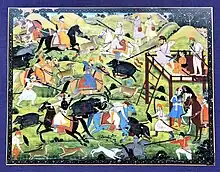
| Part of a series on |
| Sikhism |
|---|
 |
Eating meat among Nihang Sikhs[1][2] employs technique of Jhatka is practiced by sects within Sikhism when consuming meat that is either hunted or farmed. This historical method of meat consumption is popular among Nihangs and Hazuri Sikhs[1][3][4] who eat goats on the festivals throughout the year and distribute it as Mahaprashad[5] among the rest of the Sikhs as part of Langar.[6][7][8]
Debate within community
There exists a debate within this community whether or not meat consumption is part of Gurmat, i.e., within scriptural sanction of Sikh teachings. Most scholars say that these practices are misunderstood and do not equate it with sacrificial slaughter found in some other religions.[9] There are other Sikhs who have an ancestral history of conversion into the Sikh faith from Hinduism in which meat consumption is banned, and so they continue these practices as Sikhs.[2]
Militant bans
In early 1987 Kharkus issued a moral code banning the sale and consumption of meat. The ban led to much of Punjab being without meat. Those who continued to sell or eat meat risked death and commonly would have their businesses destroyed and be killed. One survey found that there were no meat or tobacco shops between Amritsar and Phagwara. In the peak of the militancy most of Punjab was meatless. Famous restaurants that served meat had removed it from their menu and denied ever serving it. The ban was popular among rural Sikhs. Kharkus justified the ban by saying, "No avatars, Hindu or Sikh, ever did these things. To eat meat is the job of rakshasas (demons) and we don't want people to become rakshasas."[10][11][12][13]
See also
References
- 1 2 "Slaughter of a goat within precints of Gurudwara on a number of occasions, apply its blood to arms/armaments kept inside the shrine, distribute its meat as Prasad among devotees at their home." The Sikh Bulletin, July–August 2009, Volume 11, Number 7 & 8, pp 26, Khalsa Tricentenneal Foundation of N.A. Inc
- 1 2 The Sikh review, Volume 46, Issues 535-540, pp 45, Sikh Cultural Centre., 1998
- ↑ "They have had a past history of serving meat in Gurdwaras, which they justify by mentioning that Nihang Sikhs traditionally sacrifice goats at Vaisakhi and Hola Mohalla at Hazur Sahib and Anandpur Sahib.",The Queen From Edinburgh, by MIKE WADE, Courtesy: The Times – Scottish Edition, Mike Wade Archived 23 September 2009 at the Wayback Machine
- ↑ WORLD SIKH CONFERENCE – SYDNEY 2004, A REPORT, pp 6. Sikh Council of Australia , www.sikhcouncil.org.au
- ↑ "A Nihang carries out 'Chatka' on a 'Chatanga' (a specially selected goat for sacrifice)", The Multifarious Faces of Sikhism throughout Sikh History, www.sarbloh.info Archived 18 July 2011 at the Wayback Machine
- ↑ "The most special occasion of the Chhauni is the festival of Diwali which is celebrated for ten days. This is the only Sikh shrine at Amritsar where Maha Prasad (meat) is served on special occasions in Langar", The Sikh review, Volume 35, Issue 409 – Volume 36, Issue 420, Sikh Cultural Centre., 1988
- ↑ "The tradition traces back to the time of Sri Guru Hargobind Sahib Ji who started the tradition of hunting for Sikhs....The tradition of ritually killing goats and consuming Mahaparshad remains alive not only with the Nihang Singh Dals, but also at Sachkhand Sri Hazoor Sahib and Sachkhand Sri Patna Sahib (two of the Sikhs holiest shrines). " Panth Akali Budha Dal Archived 23 May 2010 at the Wayback Machine
- ↑ "Another noteworthy practice performed here is that a goat is sacrificed on Dussehra night every year. This ceremony was performed on Diwali day this year (28 October 2008). The fresh blood of the sacrificed goat is used for tilak on the Guru’s weapons. ",SIGNIFICANT DEVELOPMENTS OF THE SIKH COMMUNITY, Dr Madanjit Kaur, Institute of Sikh Studies Institute of Sikh Studies, Madan Kaur
- ↑ Sacrifice at Hazur Sahib – Myth & Truth, Nanak Singh Nishter , World Sikh News, 21 January 2009
- ↑ "AISSF forces shopkeepers to shut liquor and meat shops in Punjab". India Today. Retrieved 14 September 2023.
- ↑ "Sikh militants in Punjab, putting a moral edge on... - UPI Archives". UPI. Retrieved 21 May 2023.
- ↑ Chima, Jugdep S. (11 March 2010). The Sikh Separatist Insurgency in India: Political Leadership and Ethnonationalist Movements. SAGE Publishing India. ISBN 978-93-5150-953-0.
- ↑ Fazal, Tanweer (1 August 2014). Nation-state and Minority Rights in India: Comparative Perspectives on Muslim and Sikh Identities. Routledge. ISBN 978-1-317-75178-6.
Bibliography
- In the Master's Presence: The Sikh's of Hazoor Sahib, Nidar Singh Nihang, Parmjit Singh, Kashi House, 2008